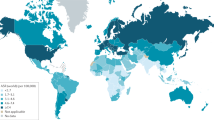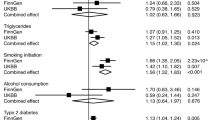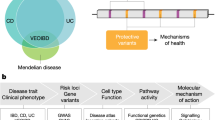Abstract
Chronic pancreatitis remains a challenging and frustrating clinical problem. In the past few years, however, advances in genetic and immunologic research have spawned new insights and approaches to chronic pancreatitis. Genetic and environmental risk assessment may help identify individuals who are likely to develop severe chronic pancreatitis early in the disease course, and allow targeted attention to reduce confounding risks and slow or prevent this problem in the future.
This is a preview of subscription content, access via your institution
Access options
Subscribe to this journal
Receive 12 print issues and online access
$209.00 per year
only $17.42 per issue
Buy this article
- Purchase on Springer Link
- Instant access to full article PDF
Prices may be subject to local taxes which are calculated during checkout


Similar content being viewed by others
References
Kloppel G and Maillet B (1991) A morphological analysis of 57 resection specimens and 9 autopsy pancreata. Pancreas 6: 266–274
Whitcomb DC et al. (1996) Hereditary pancreatitis is caused by a mutation in the cationic trypsinogen gene. Nat Genet 14: 141–145
Gorry MC et al. (1997) Mutations in the cationic trypsinogen gene are associated with recurrent acute and chronic pancreatitis. Gastroenterology 113: 1063–1068
Somogyi L et al. (2001) Recurrent acute pancreatitis: an algorithmic approach to identification and elimination of inciting factors. Gastroenterology 120: 708–717
Etemad B and Whitcomb DC (2001) Chronic pancreatitis: diagnosis, classification, and new genetic developments. Gastroenterology 120: 682–707
Schneider A and Whitcomb DC (2002) Hereditary pancreatitis: a model for inflammatory diseases of the pancreas. Best Pract Res Clin Gastroenterol 16: 347–363
Van Laethem J et al. (1996) Transforming growth factor beta promotes development of fibrosis after repeated courses of acute pancreatitis in mice. Gastroenterology 110: 576–582
Muller-Pillasch F et al. (1999) TGFbeta and the extracellular matrix in pancreatitis. Hepatogastroenterology 46: 2751–2756
Bachem MG et al. (1998) Identification, culture, and characterization of pancreatic stellate cells in rats and humans. Gastroenterology 115: 421–432
Apte MV and Wilson JS (2003) Stellate cell activation in alcoholic pancreatitis. Pancreas 27: 316–320
Whitcomb DC (2000) Genetic predispositions to acute and chronic pancreatitis. Med Clin North Am 84: 531–547
Howes N et al. (2004) Clinical and genetic characteristics of hereditary pancreatitis in Europe. Clin Gastroenterol Hepatol 2: 252–261
Teich N et al. (2000) Mutations of the activation peptide of cationic trypsinogen may lead to chronic pancreatitis by facilitated activation of trypsinogen to trypsin. Gastroenterology 118: a195
Sahin-Tóth M and Tóth M (2000) Gain-of-function mutations associated with hereditary pancreatitis enhance autoactivation of human cationic trypsinogen. Biochem Biophys Res Commun 278: 286–289
Bennett WS and Huber R (1984) Structural and functional aspects of domain motions in proteins. CRC Crit Rev Biochem 15: 291–384
Frick TW et al. (1997). Elevated calcium and activation of trypsinogen in rat pancreatic acini. Gut 41: 339–343
Sutton R et al. (2003) Signal transduction, calcium and acute pancreatitis. Pancreatology 3: 497–505
Whitcomb DC : Value of genetic testing in management of pancreatitis. Gut (in press)
Ward JB et al. (1996) Progressive disruption of acinar cell calcium signaling is an early feature of cerulein-induced pancreatitis in mice. Gastroenterology 111: 481–491
Kruger B et al. (2000) The role of intracellular calcium signaling in premature protease activation and the onset of pancreatitis. Am J Pathol 157: 43–50
Voronina S et al. (2002) Bile acids induce calcium signals in mouse pancreatic acinar cells: implications for bile-induced pancreatic pathology. J Physiol 540: 49–55
Pandol SJ et al. (1999) Ethanol diet increases the sensitivity of rats to pancreatitis induced by cholecystokinin octapeptide. Gastroenterology 117: 706–716
Li H.S. et al. (2001) Rat mitochondrial ATP synthase ATP5G3: cloning and upregulation in pancreas after chronic ethanol feeding. Physiol Genomics 6: 91–98
Teich N et al. (2002) Cathepsin B cleavage of the trypsinogen activation peptide. BMC Gastroenterol 2: 27
Kukor Z et al. (2002) Presence of cathepsin B in the human pancreatic secretory pathway and its role in trypsinogen activation during hereditary pancreatitis. J Biol Chem 277: 21389–21396
Witt H et al. (2000) Mutations in the gene encoding the serine protease inhibitor, kazal type 1 are associated with chronic pancreatitis. Nat Genet 25: 213–216
Pfützer RH et al. (2000) SPINK1/PSTI polymorphisms act as disease modifiers in familial and idiopathic chronic pancreatitis. Gastroenterology 119: 615–623
Rossi L et al. (2001) SPINK1/PSTI mutations are associated with tropical pancreatitis in Bangladesh: a preliminary report. Pancreatology 1: 242–245
Sharer N et al. (1998) Mutations of the cystic fibrosis gene in patients with chronic pancreatitis. N Eng J Med 339: 645–652
Cohn JA et al. (1998) Relation between mutations of the cystic fibrosis gene and idiopathic pancreatitis. N Engl J Med 339: 653–658
Stern RC (1997) The diagnosis of cystic fibrosis. N Engl J Med 336, 487–491
Whitcomb DC and Ermentrout DB (2004) A mathematical model of the pancreatic duct cell generating high bicarbonate concentrations in pancreatic juice. Pancreas 29: E30–E40
Reddy MM and Quinton PM (2003) Control of dynamic CFTR selectivity by glutamate and ATP in epithelial cells. Nature 423: 756–760
Choi JY et al. (2001) Aberrant CFTR-dependent HCO3- transport in mutations associated with cystic fibrosis. Nature 410: 94–97
Durno C et al. (2002) Genotype and phenotype correlations in patients with cystic fibrosis and pancreatitis. Gastroenterology 123: 1857–1864
Nguyen TD et al. (1999) Trypsin activates pancreatic duct epithelial cell ion channels through proteinase-activated receptor-2. J Clin Invest 103: 261–269
Namkung W et al. (2004) Protease-activated receptor 2 exerts local protection and mediates some systemic complications in acute pancreatitis. Gastroenterology 126: 1844–1859
Gelrud A et al. (2004) Analysis of cystic fibrosis gene product (CFTR) function in patients with pancreas divisum and recurrent acute pancreatitis. Am J Gastroenterol 99: 1557–1562
Ito T et al. (1997) Autoimmune pancreatitis as a new clinical entity. Three cases of autoimmune pancreatitis with effective steroid therapy. Dig Dis Sci 42: 1458–1468
Okazaki K et al. (2000) Autoimmune-related pancreatitis is associated with autoantibodies and a Th1/Th2-type cellular immune response. Gastroenterology 118: 573–581
Hamano H et al. (2001) High serum IgG4 concentrations in patients with sclerosing pancreatitis. N Engl J Med 344: 732–738
Sarles H (1965) Proposal adopted unanimously by the participants of the Symposium, Marseilles 1963. Bibl Gastroenterol 7: 7–8
Sarles H (1965) Pancreatitis: Symposium of Marseille, 1963. Basel: Karger
Shrikhande SV et al. (2003) Comparison of histological features and inflammatory cell reaction in alcoholic, idiopathic and tropical chronic pancreatitis. Br J Surg 90: 1565–1572
Sarner M and Cotton PB (1984) Classification of pancreatitis. Gut 25: 756–759
Homma T et al. (1997) Diagnostic criteria for chronic pancreatitis by the Japan Pancreas Society. Pancreas 15: 14–15
Author information
Authors and Affiliations
Corresponding author
Ethics declarations
Competing interests
The author declares that he owns the patent for testing for PRSS1 mutations, and has just licensed the patent to Ambry Genetics, Irvine, CA. He also serves as a consultant for Ambry Genetics and for Solvay Pharmaceuticals Inc., Marietta, GA, who make a pancreatic digestive enzyme product.
Glossary
- HEREDITARY PANCREATITIS
-
An autosomal dominant disorder. Recurrent attacks of acute pancreatitis begin in childhood, chronic pancreatitis in adolescence and pancreatic cancer later in life
- TRANSFORMING GROWTH FACTOR-β
-
This anti-inflammatory cytokine reduces the severity of acute pancreatitis, but stimulates the secretion of proteins involved in fibrosis
- FAMILIAL PANCREATITIS
-
Pancreatitis in an individual in whose family pancreatitis occurs more frequently than expected by chance alone. Genetic defects might not be present
- TROPICAL PANCREATITIS
-
An idiopathic form of recurrent acute pancreatitis and chronic pancreatitis that usually occurs in children in tropical latitudes
- COMPLEX TRAIT
-
A trait with a non-Mendelian genetic component. Its expression may require the effects of two or more genes or gene–environment interactions
- CHLORIDE-BICARBONATE ANTIPORTER
-
A membrane-bound ion-exchange molecule that transports chloride and bicarbonate across cell membranes in opposite directions
- SPHINCTEROTOMY
-
A technique used to decrease resistance to the flow of bile or pancreatic juice and to facilitate the passage of material from the pancreatic ducts
- MENDELIAN INHERITANCE
-
Conditions in which genetic traits are passed from parents to offspring following autosomal dominant, autosomal recessive or sex linked patterns
Rights and permissions
About this article
Cite this article
Whitcomb, D. Mechanisms of Disease: advances in understanding the mechanisms leading to chronic pancreatitis. Nat Rev Gastroenterol Hepatol 1, 46–52 (2004). https://doi.org/10.1038/ncpgasthep0025
Issue Date:
DOI: https://doi.org/10.1038/ncpgasthep0025
This article is cited by
-
Sarcopenia in Chronic Pancreatitis – Prevalence, Diagnosis, Mechanisms and Potential Therapies
Current Gastroenterology Reports (2022)
-
Evidence for diagnosis of early chronic pancreatitis after three episodes of acute pancreatitis: a cross-sectional multicentre international study with experimental animal model
Scientific Reports (2021)
-
Progression of recurrent acute to chronic pancreatitis: More questions than answers!
Indian Journal of Gastroenterology (2018)
-
An Evaluation of Factors Associated With Pathogenic PRSS1, SPINK1, CTFR, and/or CTRC Genetic Variants in Patients With Idiopathic Pancreatitis
American Journal of Gastroenterology (2017)
-
What is personalized medicine and what should it replace?
Nature Reviews Gastroenterology & Hepatology (2012)



